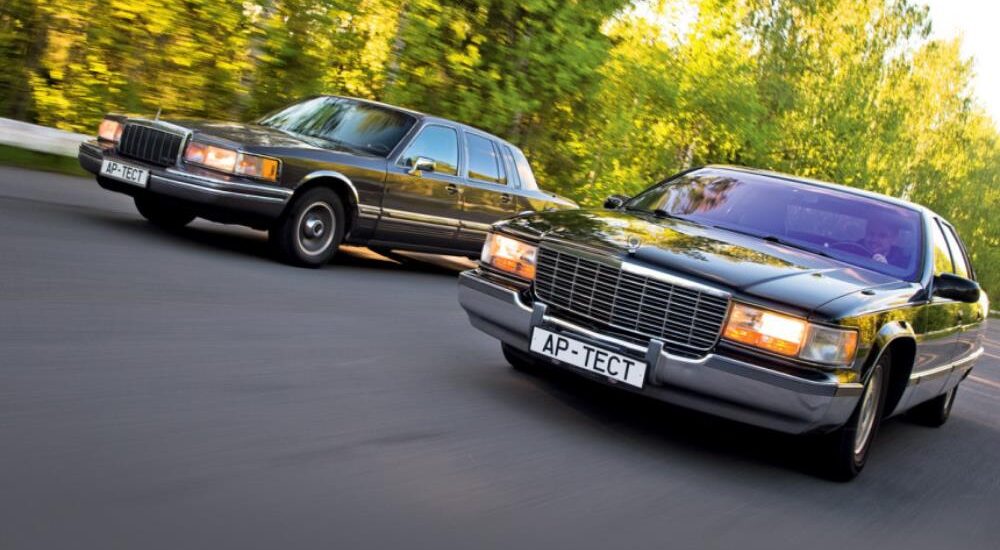Are you ready to step back into the 90s? Picture this: You close the weighty, secure door behind you, sink into the luxurious driver’s seat, and engage the gear selector, turning the steering wheel almost four times before gently easing onto the Dmitrovskoye Highway. It’s not just a car; it’s an experience reminiscent of a bygone era. Enter the Lincoln Town Car and the Cadillac Fleetwood Brougham, two titans of American automotive luxury from the 1990s, here for a head-to-head comparison like never before.
The debut of the Fleetwood in 1993 was nothing short of dazzling. Chrome accents and emblematic medallions adorned its imposing exterior. Gleaming trim, crafted from polished metal, adorned the sills and fenders, even the bumpers. For an extra $1,600, you could opt for chrome wheels, and for another $925, a vinyl roof covering completed the look.
The Fleetwood Brougham epitomized the essence of Cadillac — introduced to mark the brand’s 90th anniversary, it boasted a 10 cm increase in length over its predecessor while retaining its classic frame. This model even served as the foundation for President Bill Clinton’s official limousine. However, despite its grandeur, it struggled to compete with the likes of Mercedes and Lexus. By the end of 1996, General Motors ceased production of the Fleetwood, marking the end of an era for the body-on-frame, rear-wheel-drive sedan.
Much like the ill-fated Titanic, the Fleetwood met its demise before it could truly shine. Equipped with a new 5.7-liter engine, delivering 264 horsepower, and an upgraded transmission in 1994, it was a powerhouse on the road. Our test vehicle, the final 1996 model, showcased the pinnacle of its evolution.
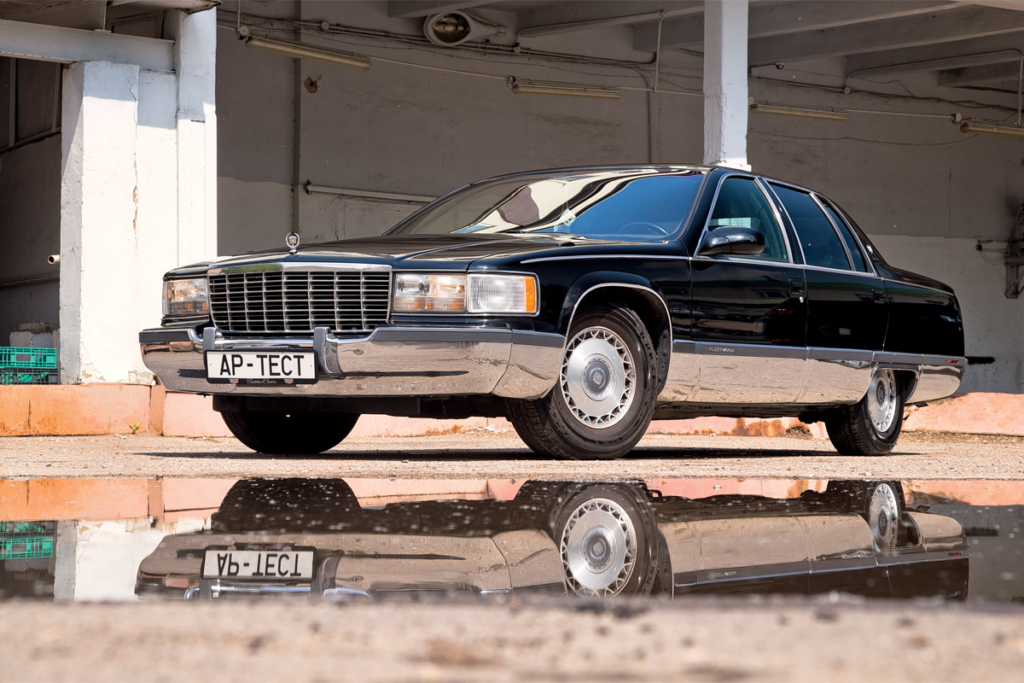
Chrome details are a heavy burden for any retro car owner. On the Cadillac, they are in the most “sandblasted places.” Either you need to order replacement panels from the USA, or re-chrome the old ones at astronomical prices.
Navigating the length of the Fleetwood feels akin to traversing a city block. It’s a behemoth of a car, demanding attention at every turn. From its lengthy, sloping hood to its retro-inspired rear, it’s as if two distinct vehicles were melded into one. This is no ordinary sedan — it’s a statement, a testament to American automotive ingenuity.
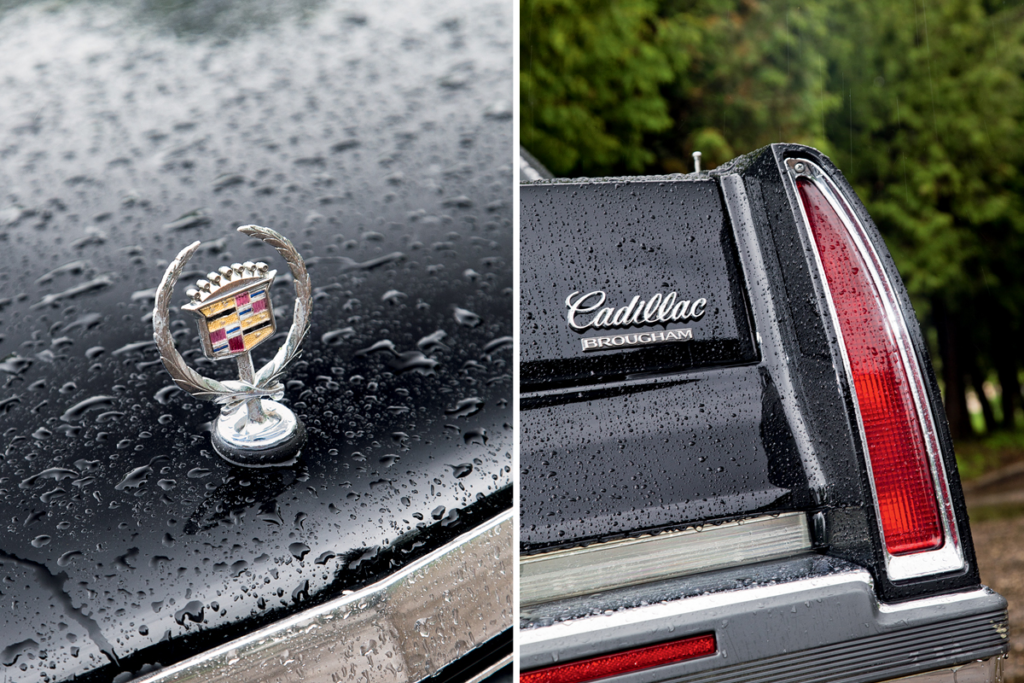
The emblem with the “ducks” also became history. In 2000, the birds disappeared from the emblem (six swans on yellow panels), and in 2014, so did the wreath.
The shining calligraphy on the body is just the “starter kit” of a Cadillac, for an extra fee you could get emblems and inscriptions covered in 24-carat gold, and even a gold-plated ignition key.
Built upon GM’s venerable D-body platform, the Fleetwood retained its traditional frame and rigid rear axle, augmented by pneumatic elements for added comfort and stability.
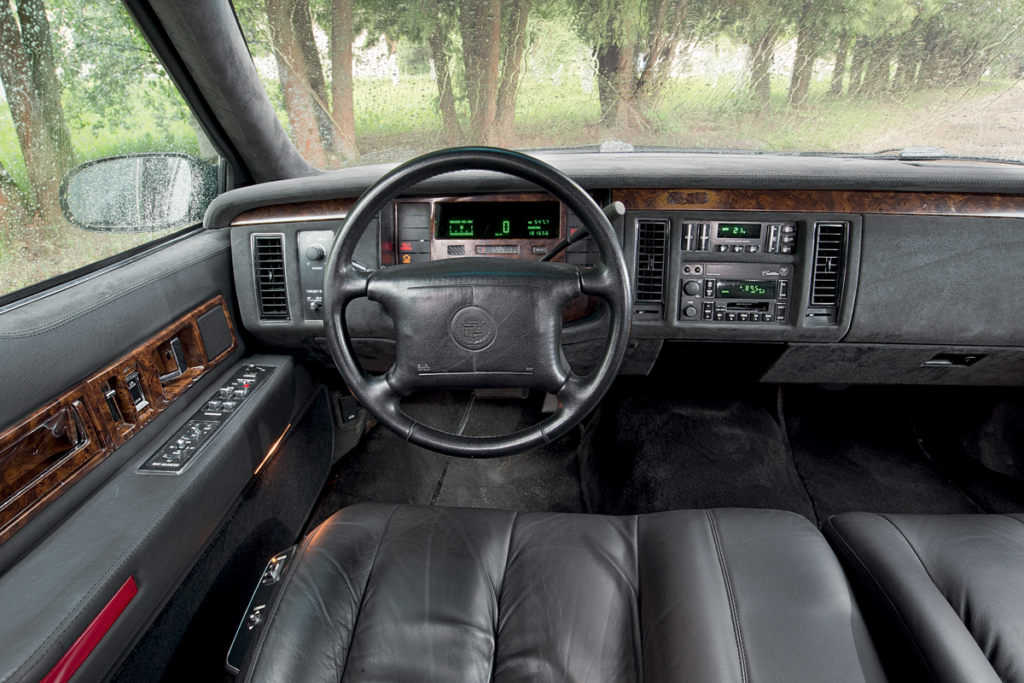
The dimensions of a Cadillac are not only in the length of the hood, the width of the couch, and the height of the front panel. The driving experience is not far behind the visual – the steering wheel makes 3.5 turns from lock to lock. But why in such a large car was there not enough space for a footrest for the left foot?
While other manufacturers pursued aerodynamic enhancements, Cadillac maintained its iconic design, evident in the distinctive curve of the open door and the sleek profile with a drag coefficient of 0.36.
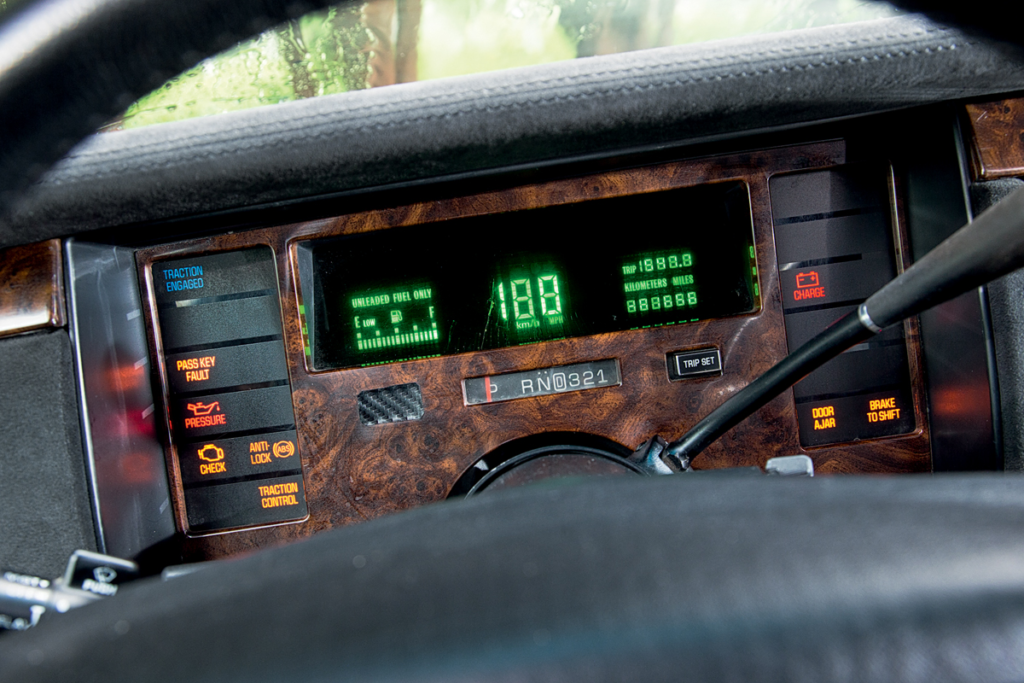
Brevity is the sister of informativeness? Speed, mileage, and fuel reserve – everything a driver needs to know. Plus a few signal lamps.
Inside, the Fleetwood exudes opulence at every touchpoint. The door handle feels akin to that of a diplomat’s briefcase, while the sumptuous sofa-like seats evoke images of a Texan villa’s living room. Despite its commanding presence on the road, the seating position remains surprisingly low, offering a unique perspective that invites you to savor the journey ahead.
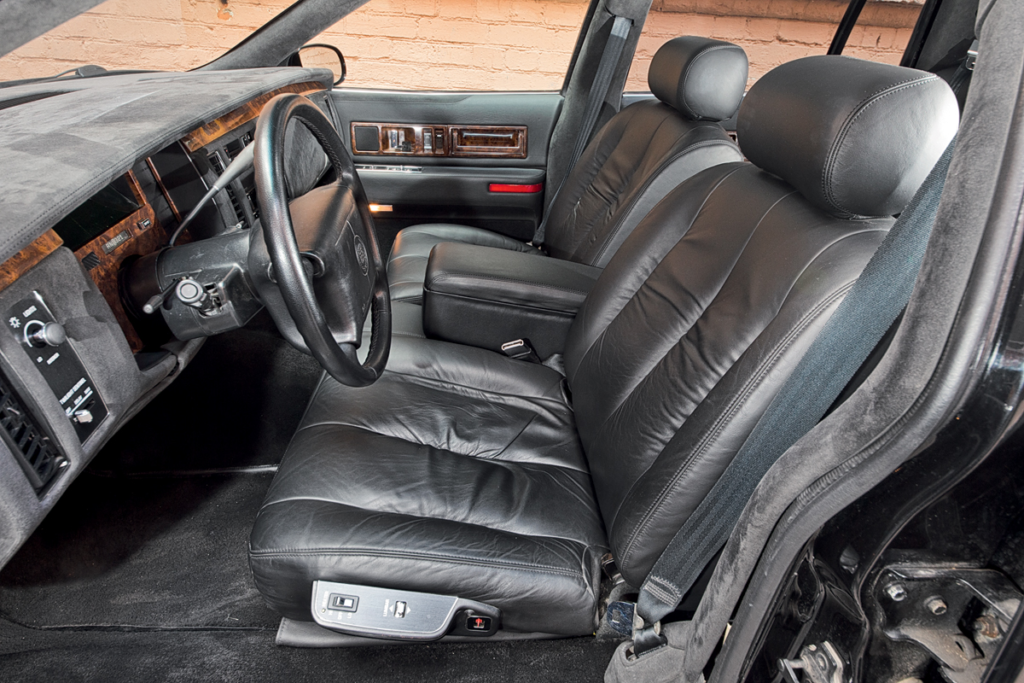
The leather interior required an additional payment of $570, but the split half-couch with a full set of power adjustments is standard equipment. With the armrest raised, it can accommodate three people (the passenger airbag covers both right seats). The history of six-seat GM sedans ended only in 2011 on the Chevrolet Impala model.
The interior of the Fleetwood, despite showing signs of wear, has been meticulously restored to its former glory. Adorned with black leather, quilted sofas, chrome accents, and wood inserts, it exudes a sense of timeless elegance. The expansive dashboard, once leather-clad with embossed “Cadillac” lettering, now boasts Alcantara upholstery. It’s worth noting that Tesla’s “furniture” architecture in the Model 3 harkens back to the traditional American cabin layout, where the driver occupies a position akin to a desk.

This sofa is so tempting just by its appearance alone. But the most comfortable thing to do here is just to sit back and enjoy the atmosphere and the outstanding smoothness of the Cadillac’s ride.
Measuring five meters and seventy centimeters in length, the Fleetwood surpasses even the long-wheelbase S-Class in size. However, despite its generous dimensions, the rear passengers are greeted with amenities far from the level of comfort offered by European and Japanese executive sedans of the era. With minimal seat adjustments and no entertainment options, passengers are left to luxuriate in the plush sofa amidst the semi-darkness, obscured by the wide roof pillars. Cadillac’s brochures emphasized that competitors such as Mercedes, BMW, and Lexus were not in the same league as the Fleetwood, with the Lincoln Town Car standing as its sole external rival.

Most of the seat adjustment buttons and joysticks are located on the door. And of course, they are all covered in chrome imitation.
Time has a way of revealing irony. The design of the Lincoln Town Car has remained virtually unchanged since 1980, with its characteristic hood and trunk slabs, high cabin profile, turbine wheels, imposing radiator grille, and narrow rear window pillar. Even as automotive design evolved, Lincoln remained steadfast in its adherence to these enduring design cues. Three decades later, juxtaposed against Cadillac’s more contemporary aesthetic, the Lincoln Town Car exudes a timeless allure, akin to an ancient temple standing the test of time.
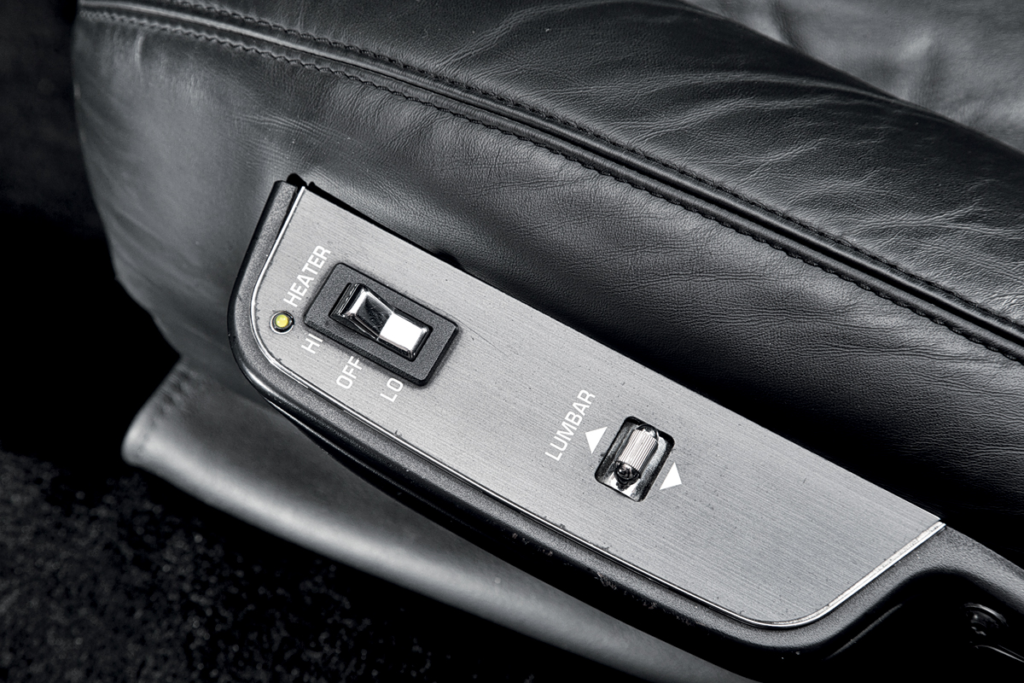
Heated front seats and lumbar support adjustment are part of the standard equipment in the Brougham version.
However, perceptions quickly shift once you step inside the Lincoln Town Car. If the Cadillac’s interior evokes images of an old villa, then the Town Car… Could it be likened to a district illuminated by red lights?
In truth, the burgundy interior pays homage to theatrical traditions. Ever wonder why seats in auditoriums are often upholstered in red? It’s because red is the last color we lose sight of in the dark. Lincoln saloons dating back to the 1960s aimed to capture the ambiance of grand opera halls, offering optional velvet upholstery in a rich Currant Red that was cherished nearly as much as leather.
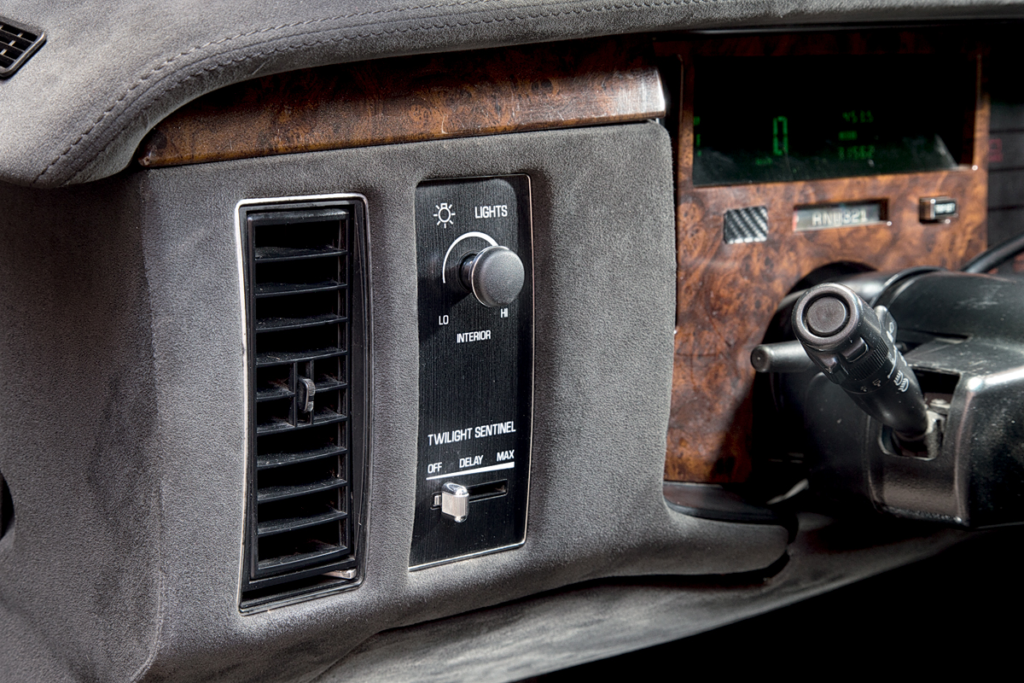
The only steering wheel lever is overloaded like on Mercedes. The lights are turned on by pulling the stalk towards oneself, and the Twilight Sentinel is Cadillac’s “auto” mode tied to the light sensor.
Step inside, and you’re not entering a car interior but rather a theater box. However, this dramatic flair doesn’t necessarily translate into comfort and practicality. The space surrounding the rear sofa is both lower and narrower compared to the Fleetwood, lacking additional amenities apart from embroidered emblems. Surprisingly, legroom is slightly more abundant than in the Cadillac, despite the Lincoln’s wheelbase being nearly 11 cm shorter. This is mainly due to the severely limited movements of the front seats. The range of adjustment for the seats is so restricted that tall drivers find themselves uncomfortably close to the pedals, while shorter drivers must stretch to reach them.
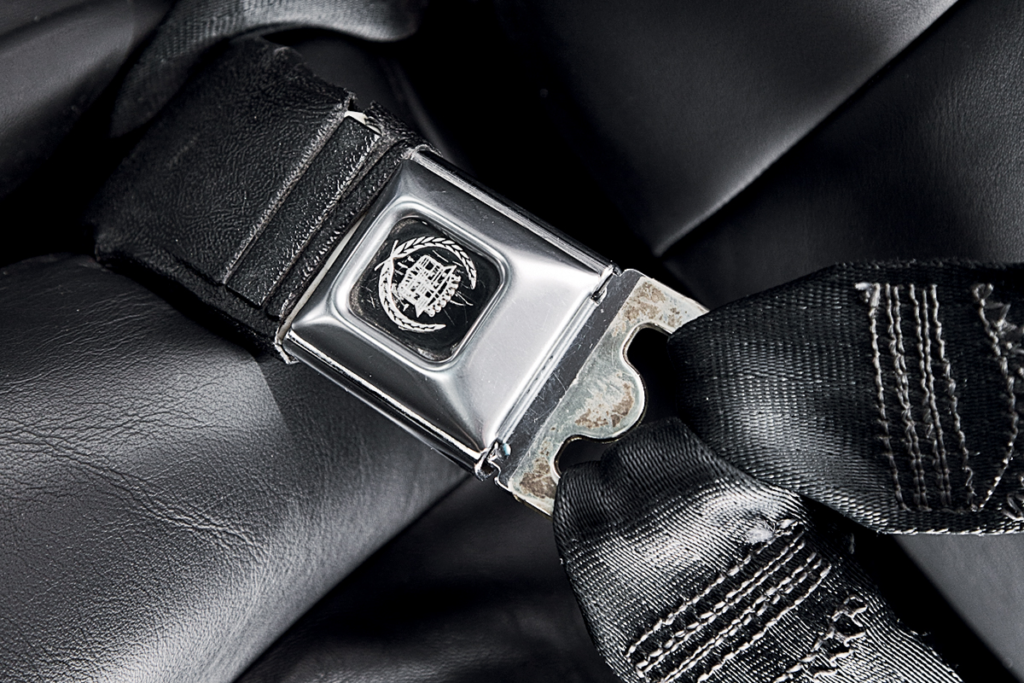
The seatbelt locks are a work of art. The Cadillac has two inertia reels, and the belt tongue is fixed in place.
Furthermore, the thin steering wheel and antiquated instruments harken back to the 19th century. While the 1989 Town Car introduced a fluorescent digital panel, basic models were equipped with vintage analog speedometers. It’s as if stepping into this car after the Cadillac thrusts you into a time warp of at least a decade. While onlookers may perceive the Lincoln as a timeless classic, the driver can’t shake the feeling of being transported back to an era of antique carriages.
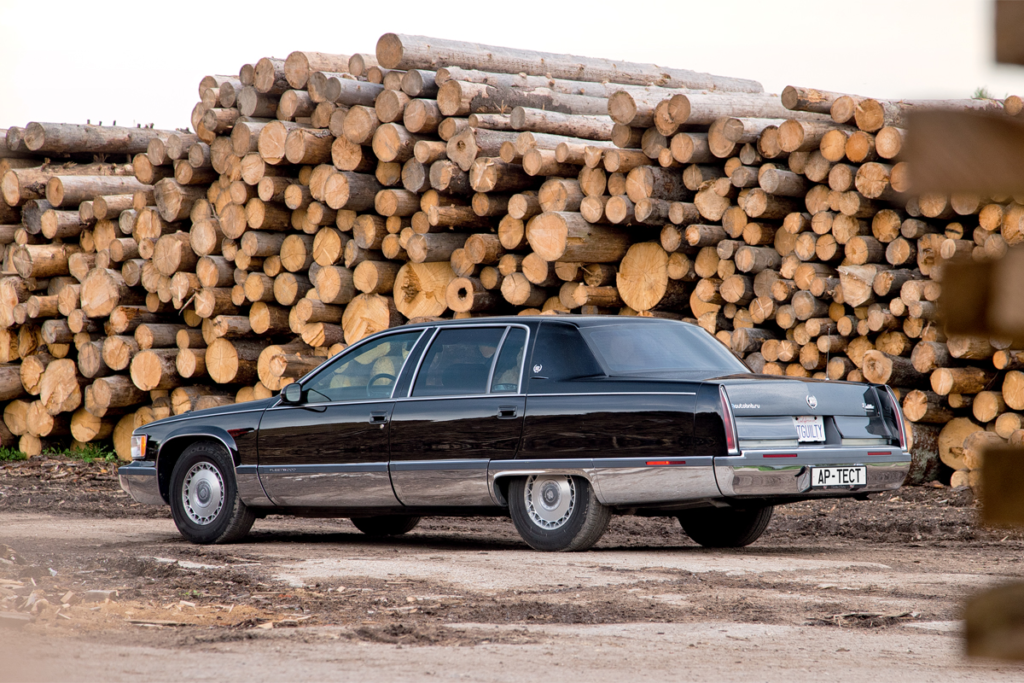
The 235/70 R15 tires make a defining contribution to the smoothness of the ride. But also to the handling. Part of the chrome trim around the rear fender is removed to facilitate tire replacement.
However, both the Town Car and the Fleetwood, despite their outward appearance, are designed with the driver in mind. They belong to the category of owner-driven cars, meaning they’re intended for owners who don’t mind getting behind the wheel themselves. With this in mind, Yaroslav Tsyplyenkov and I embarked on a comprehensive driving test of these vehicles, offering little leeway for their age. And we weren’t disappointed.
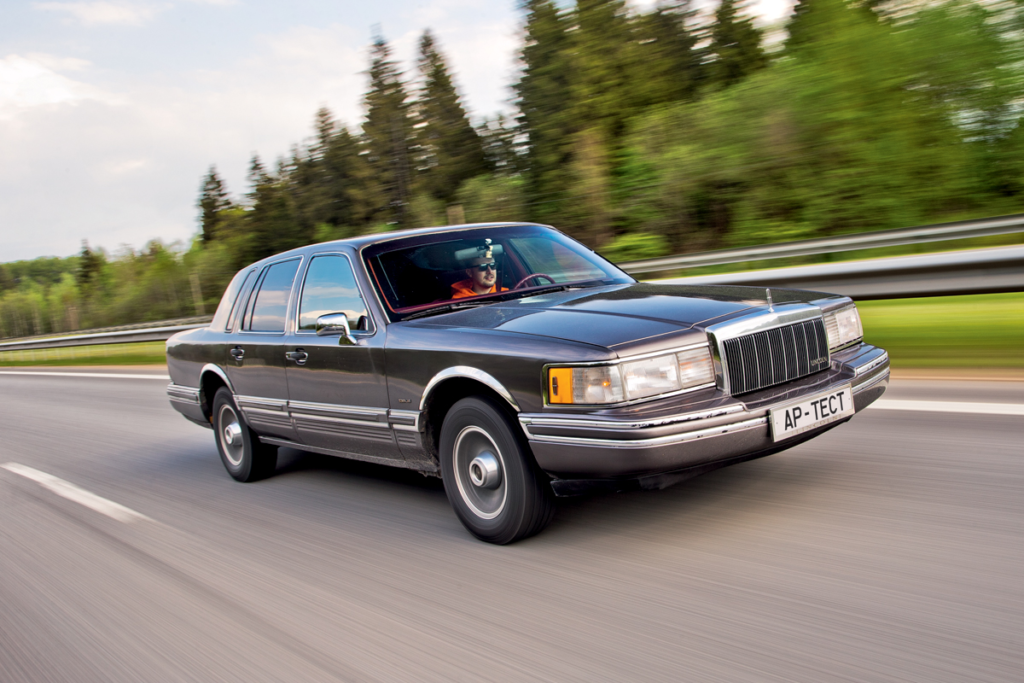
The proportions of the headlights and grille are timeless classics. Thanks to its appearance and frame construction, the Town Car was widely imported to Russia and other post-Soviet countries for use as limousine rentals, so, unlike the Cadillac, it’s much easier to find donor parts for the Lincoln.
These cars, due to their construction and condition, present a fascinating yet eclectic mix of disparate and sometimes conflicting driving characteristics. In a modern vehicle, these traits would ideally be seamlessly integrated into a cohesive driving experience, but the Cadillac and Lincoln feel as though they’re presenting themselves to the driver on a chopping board.
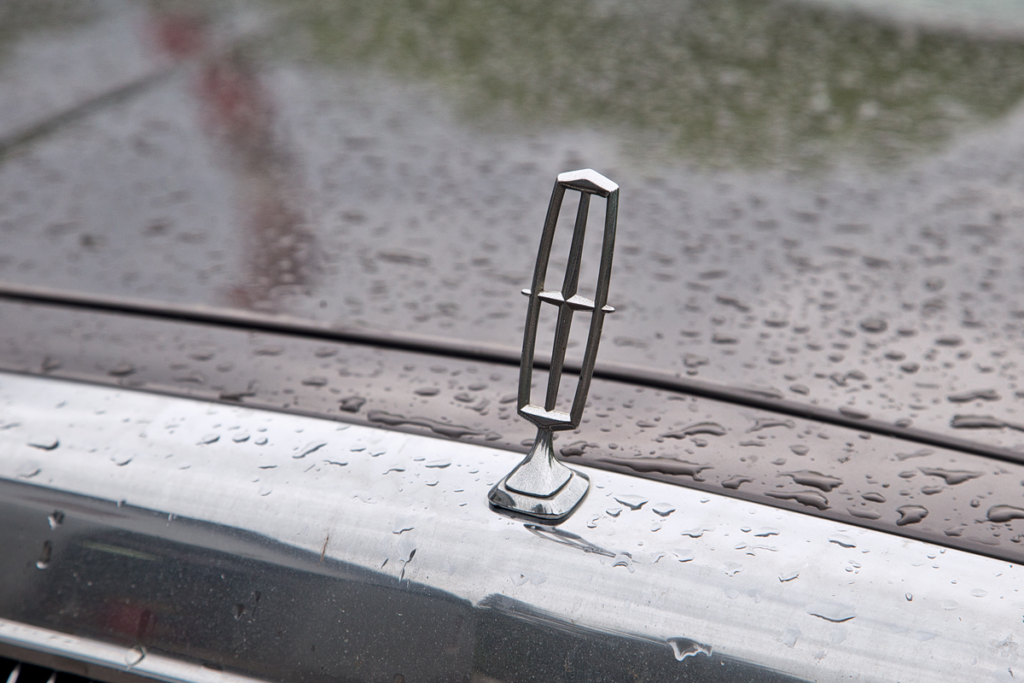
The Lincoln emblem is more modest, as is the entire body decor.
Consider acceleration without feedback, for instance. This is precisely how the Fleetwood behaves. Depressing the heavy gas pedal requires a significant amount of pressure. In response, the Cadillac moves off smoothly, and with added pressure, it lunges forward. However, there’s little control over this process as it unfolds. With no tachometer or gear indicator, even gauging the shifts by feel proves challenging, as the four-speed automatic transmission operates exceptionally smoothly. This design is tailored to alleviate the driver from worrying about such minutiae—simply depress the pedal and await the seamless execution of actions.
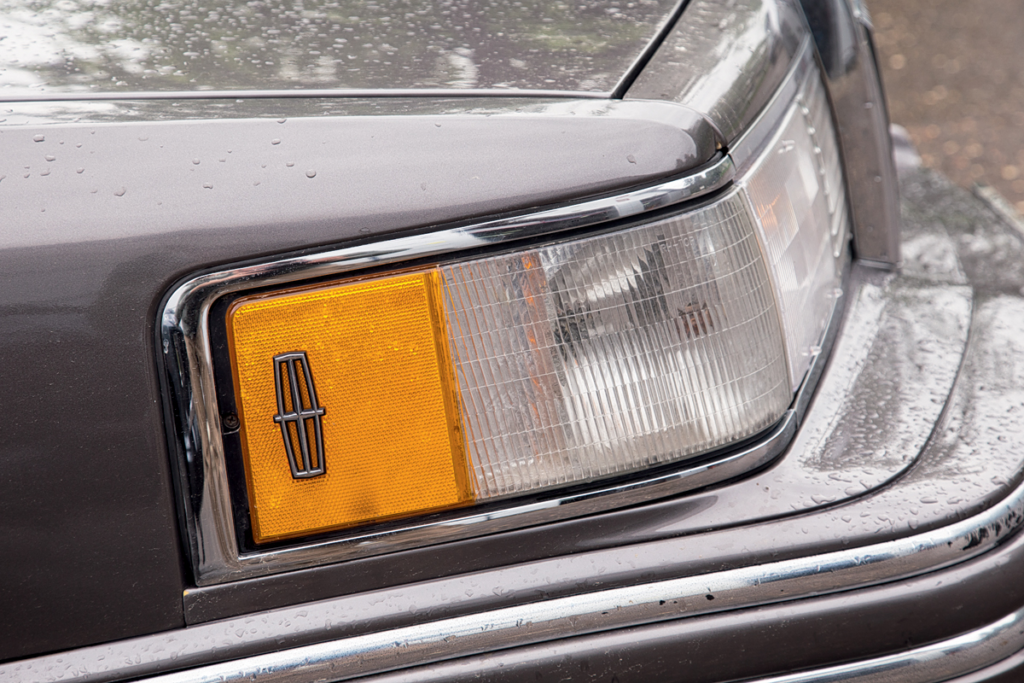
Corrosion-free fenders, chrome, and functional electronics — a rare set for a healthy Lincoln.
Yet, the Fleetwood’s maximum acceleration capabilities are nothing short of remarkable. The LT1 5.7-liter V8 engine purrs with richness and never lacks in power, boasting 264 horsepower and an impressive 447 newton-meters of torque. For the Brougham version, a “shortened” main gear ratio of 2.93 was specifically installed on the Fleetwood, replacing the standard 2.56 ratio.
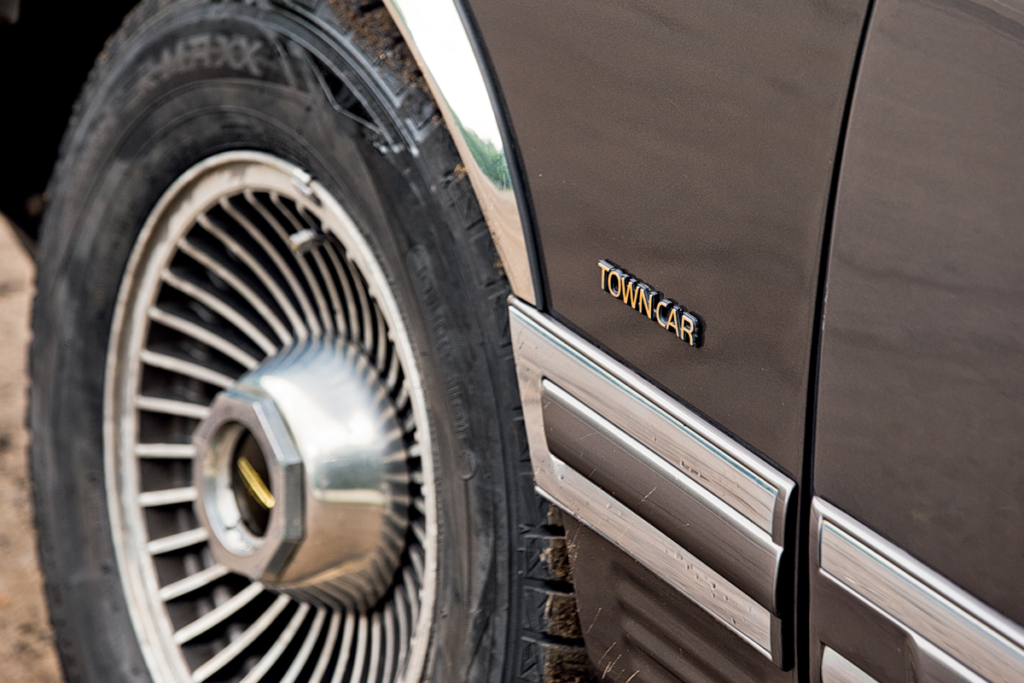
The wheels with a “turbine” pattern are Lincoln’s signature style since the 70s. The hubs are covered with decorative imitation center caps.
Acceleration to the first hundred takes 10.9 seconds, as the engine initially seems to hesitate at the start. However, once it kicks in, the pull is so strong that it borders on intimidating. As the electronic speedometer ticks upward, reaching one hundred seventy, one hundred eighty, and beyond, the Cadillac maintains its course, albeit with some noticeable shuddering at full throttle.
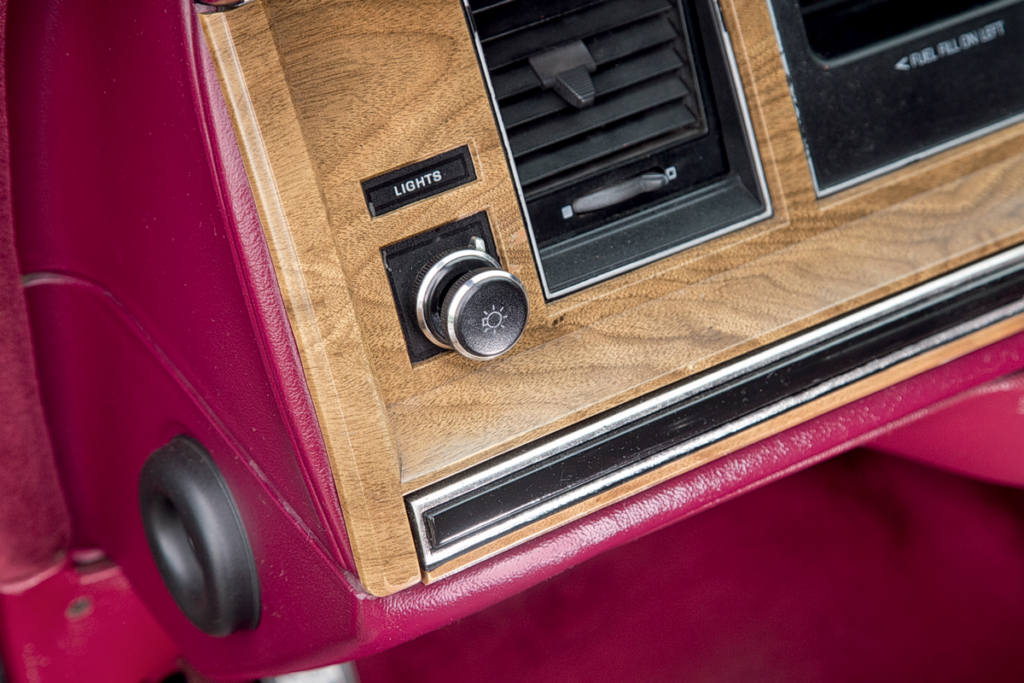
A modest pull-out handle turns on the marker and low beams.
The values continue to climb until they reach a point where, on the digital display of the Fleetwood, it appears that the figure simply isn’t encoded, causing the readings to “reset” after 200 km/h. Yet, the acceleration doesn’t cease, climbing steadily past 200 km/h. Andrey Mokhov recorded a top speed of 209.5 km/h before I eased off the accelerator, mindful of the car’s substantial curb weight of two tons and rear drum brakes that likely hadn’t experienced such speeds in quite some time.
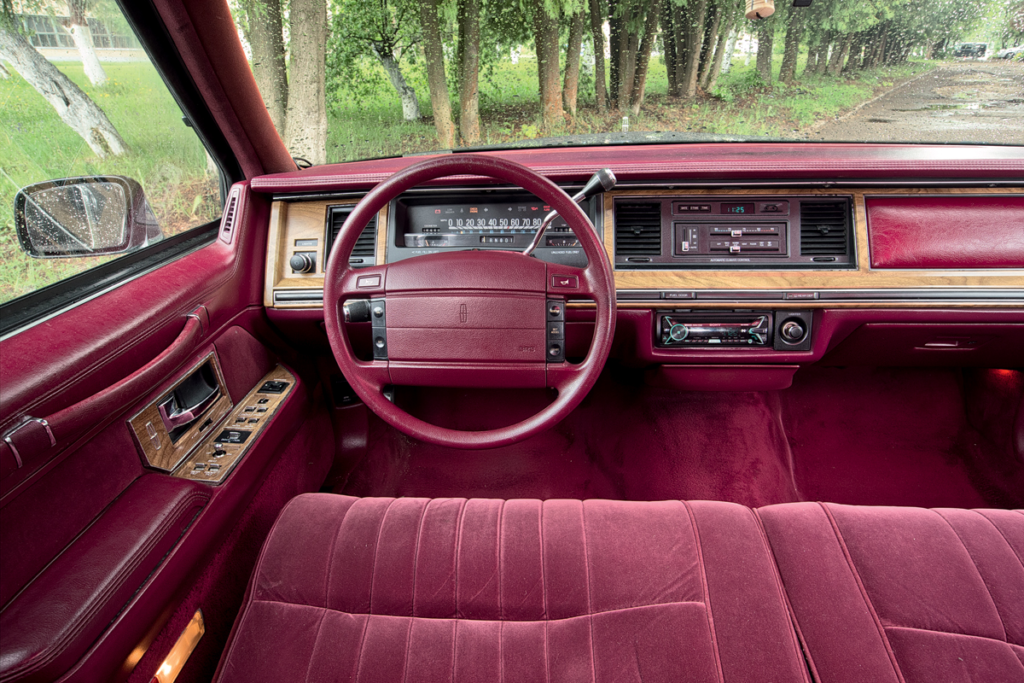
The 90s on the outside, the 80s on the inside. The thin steering wheel and old instruments add age to the Lincoln. But with burgundy velour, you can forgive a lot. Moreover, the Town Car offers a steering wheel with cruise control buttons, which the Cadillac was fundamentally deprived of.
Surprisingly, the Fleetwood’s brakes perform admirably well. There’s a reassuring feedback from the pedal, which offers resistance after a slight free play, enabling precise control over deceleration. However, we didn’t measure the braking distance as the ABS seemed to have taken a day off, along with all the other electronics in the car, including traction control, which is standard equipment.
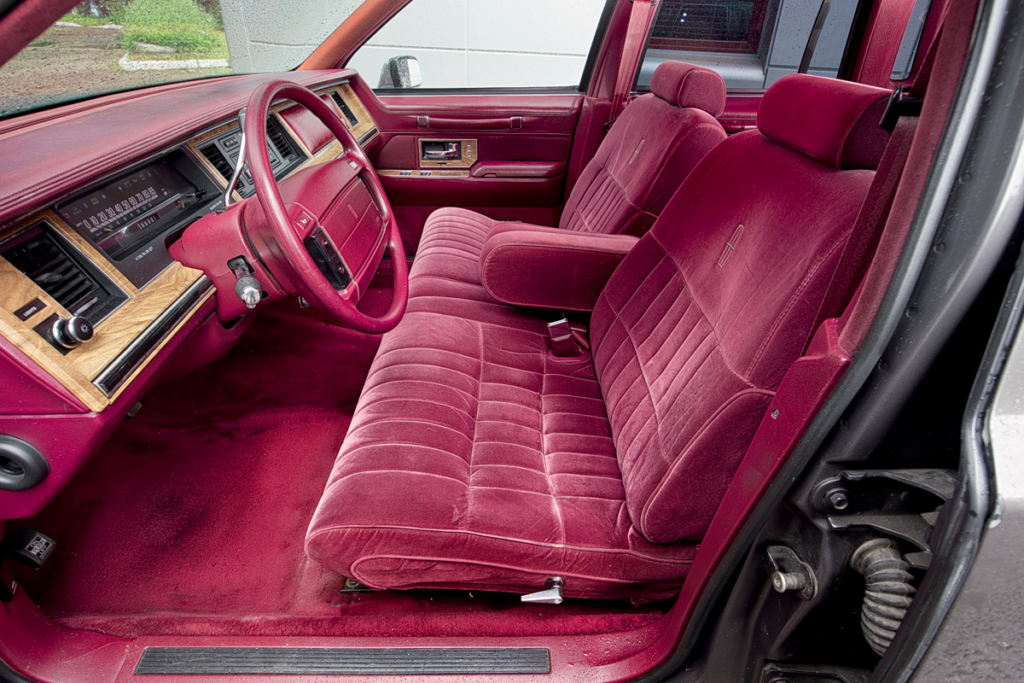
The front bench in the Lincoln is also designed for three, and the profile here is better suited for such seating. But the passenger airbag in the 1991 model year was optional.
Now, onto the Lincoln Town Car—a vehicle characterized by its responsiveness but somewhat lacking in acceleration. In 1990, it received a new “modular” overhead V8 4.6 engine, producing 193 horsepower, an improvement over its predecessor. Like the Fleetwood, there’s no tachometer or gear indicator, and the automatic transmission operates smoothly. Compared to the Cadillac, the Town Car feels almost like a “hot” hatchback, reacting promptly to every touch of the accelerator. However, its acceleration performance falls short, taking 11.3 seconds to reach “hundred.” Beyond that mark, the acceleration feels strained, reaching a maximum of 85 mph (136 km/h) before hitting the limiter. Mokhov noted a top speed of 168 km/h.


You don’t go to the theater every day, and the red interior of the Lincoln is not the best fit for everyday routine either. But at least once in your life, you need to sit here and ride as if you’re going to the premiere of your own musical.
Both cars may seem equivalent to three hundred for the driver, but the Town Car presents a challenge in driving straight. Constant corrections are necessary, exacerbated by the play in the steering wheel. There’s no clear zero position—the wheel oscillates between two “working” positions, neither aligning with straight-line motion. Corrections are needed at any speed, complicated by the Lincoln’s tendency to steer smoothly to the right but sharply to the left, with the steering wheel failing to return to center on its own. It’s a true test of bravery, though unlikely intentional by Ford.
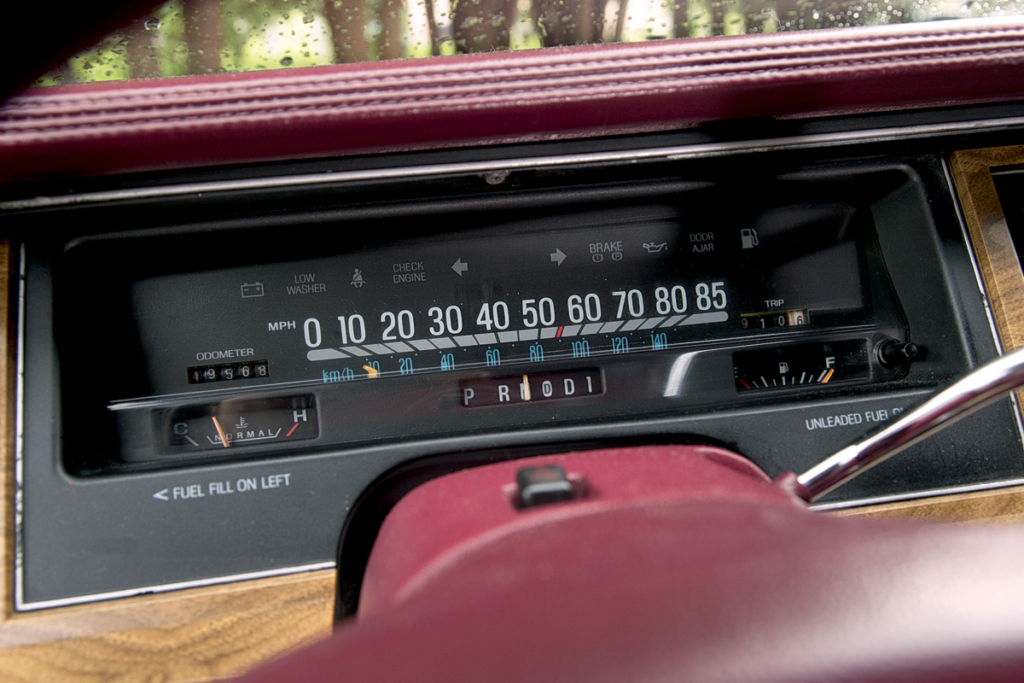
Lincoln supplements the minimal information set with a coolant temperature gauge. But the old-style speedometer doesn’t match the capabilities of the “new” 4.6 engine.
Only at speeds up to 100 km/h can one relax slightly, though corrections are still necessary, albeit less urgently. This reflects the Town Car’s leisurely style—gentle pace, subtle engine hum, seamless shifts, one hand on the wheel, the other draped over the front bench backrest. It embodies the essence of a “city car,” not one built for racing.
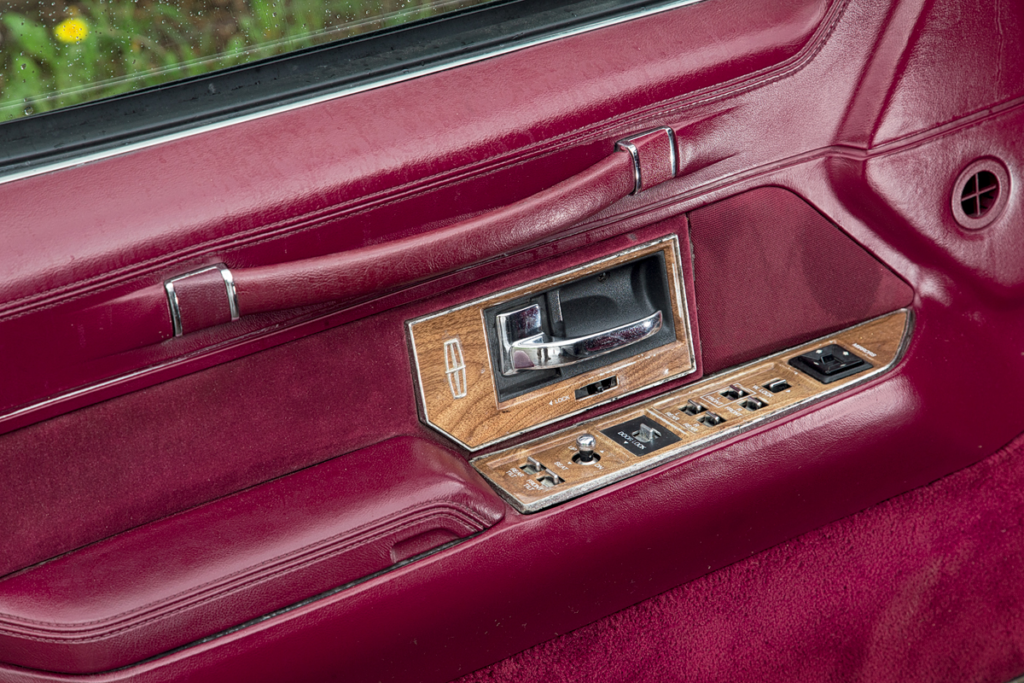
The power seat control panel of the driver’s half of the bench is next to the power window switches, but the backrest of the Lincoln is manually adjustable.
However, the Lincoln excels in braking, with a pedal setup that’s modern and even superior to the Fleetwood’s. It also handles turns better than the Cadillac. The Fleetwood, in contrast, tends to wander. While its steering wheel doesn’t exhibit play, it feels somewhat empty at zero, prompting subconscious swaying. Yet, forcing stillness reveals that the car merely wiggles slightly off course but doesn’t alter direction.
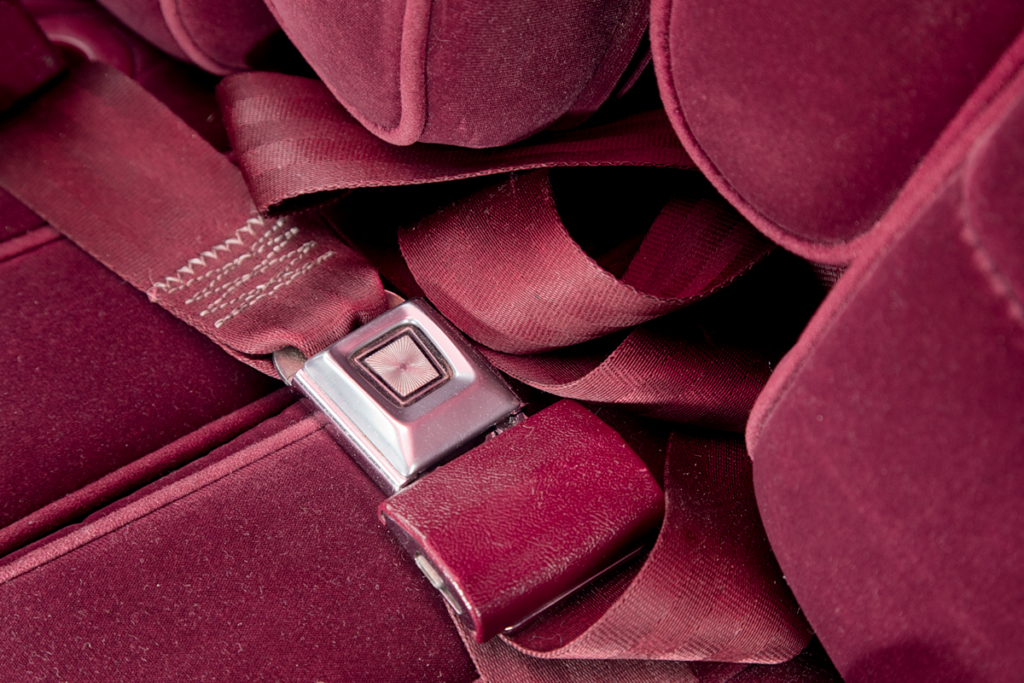
Inertial seat belts, like in the Cadillac, are provided only for four passengers.
In turns, the Fleetwood’s delayed steering response is pronounced. Despite turning the wheel and encountering resistance, the car persists in its forward trajectory. When it eventually responds, it initially leans before depending largely on speed for maneuverability. At low speeds, it turns calmly, but if speed is excessive, steering efforts result only in squealing tires. Continuous wheel-turning achieves little beyond drifting. Redirecting the car inward requires releasing the throttle and awaiting the Fleetwood’s readiness to turn.

A large lever controls the turn signals, wipers, and high beams. The small one is for adjusting the tilt of the steering wheel.
On the other hand, Lincoln demonstrates agility within its wide turning radius, akin to the Cadillac. Despite similar large rolls and an uninformative steering wheel, the Town Car exhibits minimal understeer when the steering wheel is turned, transitioning smoothly to a steeper trajectory. Lifting off the gas prompts a noticeable dive and slide, offering a glimpse of a more dynamic driving experience, if not for its smooth ride.

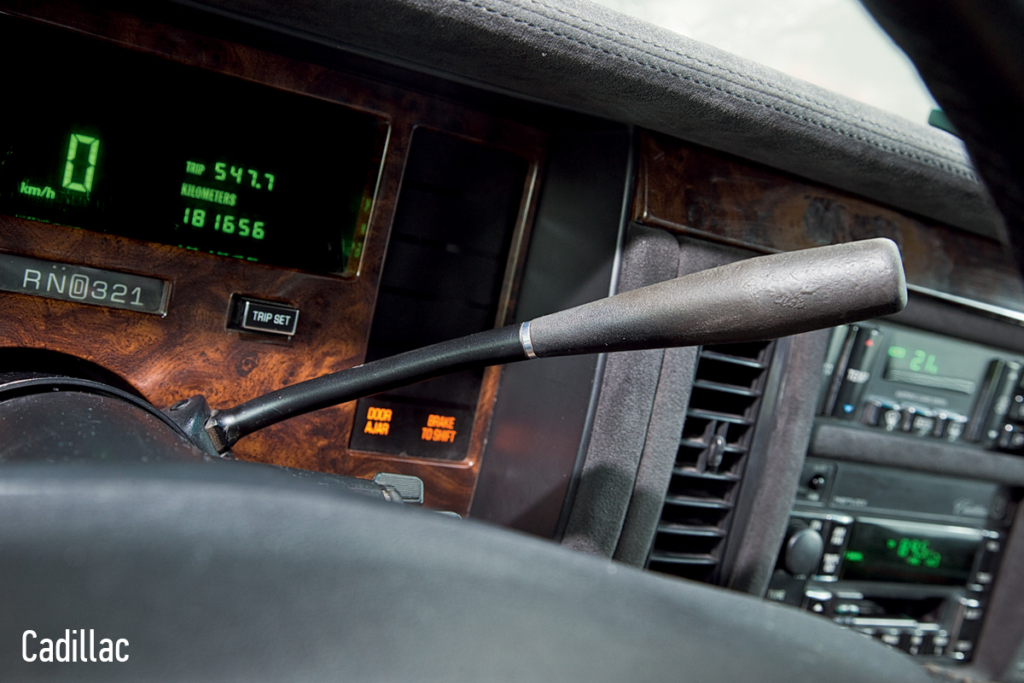
Both “fire irons” move tightly and with approximate accuracy; even mechanical indicators of the selected position do not always help determine where the lever landed.
Equipped with front springs and rear pneumatic balloons, the Town Car’s suspension struggles with anything beyond micro-profile roads. Medium to large irregularities result in jolts and rattles, while speed bumps expose the stiffness of the “air suspension” compared to springs. Long waves provoke rocking, compounded by yawing in turns, ultimately diminishing the car’s handling allure.


Climate control panels in both cars have automatic modes but do not allow manual adjustment of airflow distribution.
In contrast, the Cadillac sets a high standard for ride smoothness, rivaling few modern cars. Micro-profile and short waves hardly register, cushioned by a gentle push and modest vibration from unsprung masses. It navigates speed bumps with ease, swaying lightly, while body waves barely unsettle it. Even on dirt roads, the Cadillac remains remarkably composed, cementing its status as one of the most comfortable cars we’ve tested in years.
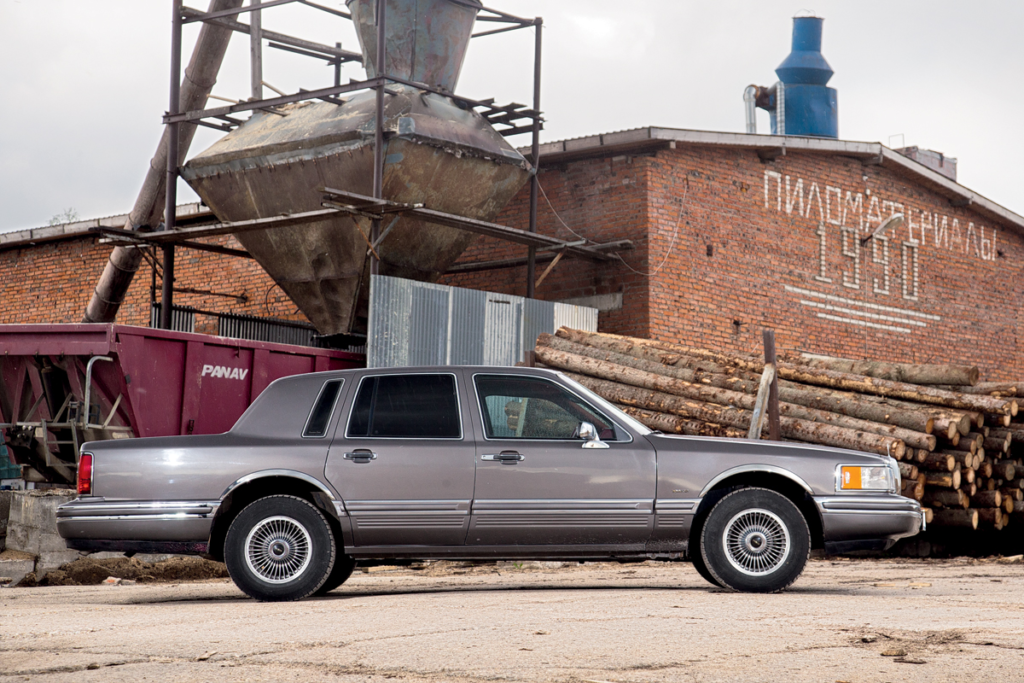
Traditional for Lincolns, the window in the rear pillar of the body is called an “opera window,” inherited from limousines with folding “opera” seats for additional passengers. But the Town Car lost this window already in 1997.
Indeed, Cadillac and Lincoln embody charisma, tradition, and contradiction, offering insights into the evolution of modern cars from the 1990s to the 2020s. While modern cars have gained handling and structural integrity, they’ve sacrificed the design spirit and class of ride smoothness evident in these classics.


In November 1990, Lincoln received the overhead Modular 4.6 engine with distributed injection. Ford invested $750 million in this architecture and still uses “modular” engines in Mustangs. These engines were also used in Rover, Panoz, and even Koenigsegg. Cadillac used the bottom-mounted LT1 “eight” based on the Corvette engine — the last generation of the legendary small-block family.
While it’s true that large American frame sedans have formally vanished, their legacy lives on. Behind the wheel of the Cadillac, one can’t shake the feeling of piloting a large SUV masquerading as a sedan. Indeed, modern frame SUVs can be considered the spiritual successors of the Fleetwood and Town Car. It’s no coincidence that following the cessation of Cadillac production, the Texas plant in Arlington shifted focus to the Escalade and Suburban.
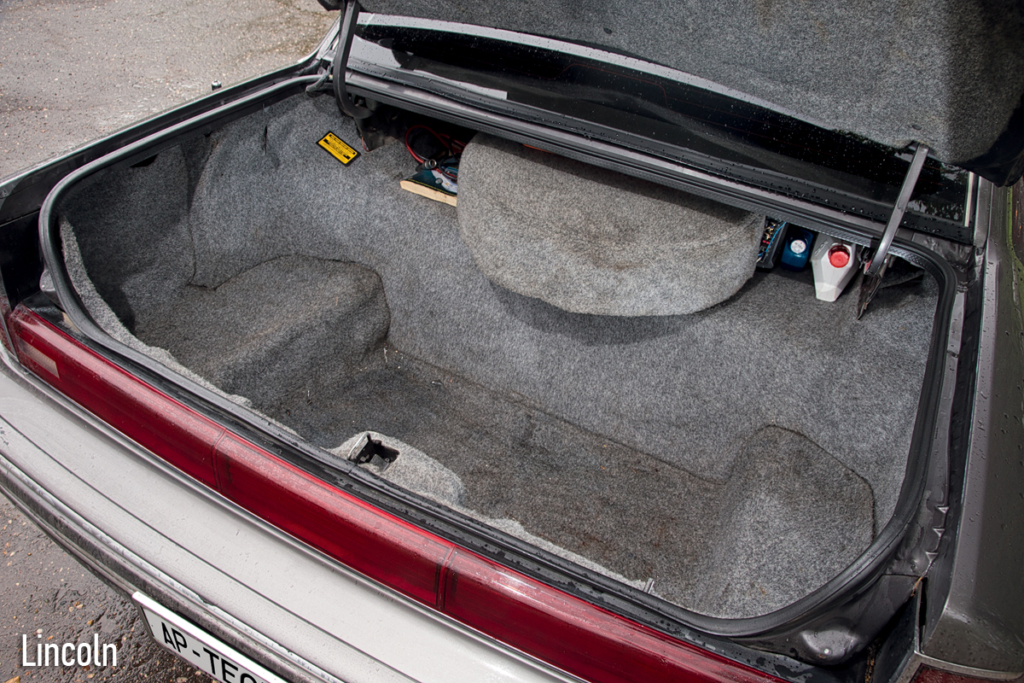
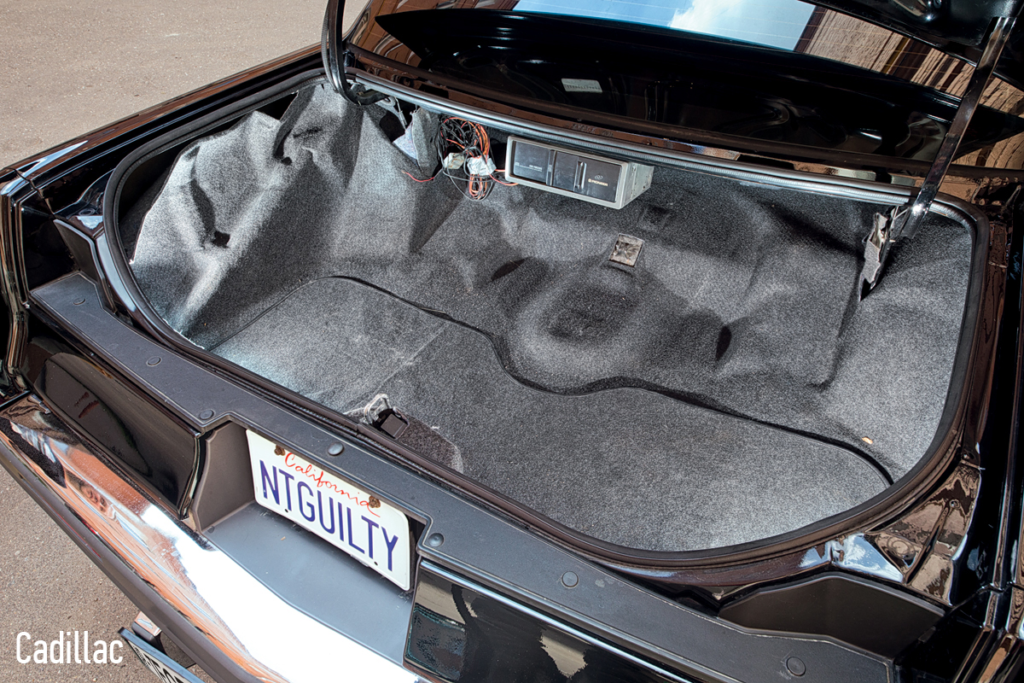
Infinite trunks compete in the inconvenience of loading and unevenness of the floor; Lincoln promises 631 liters of usable space, Cadillac — 588 liters. In both cases, the lid is equipped with a closing assist. The Fleetwood’s fuel filler neck is located under the rear license plate.
If you were to approach the Fleetwood today as you would a large SUV, you might find that in many ways, it remains relevant. It’s a concept that’s beyond Lincoln’s capabilities; for the Town Car, it’s nothing more than a relic reserved for weekend outings.
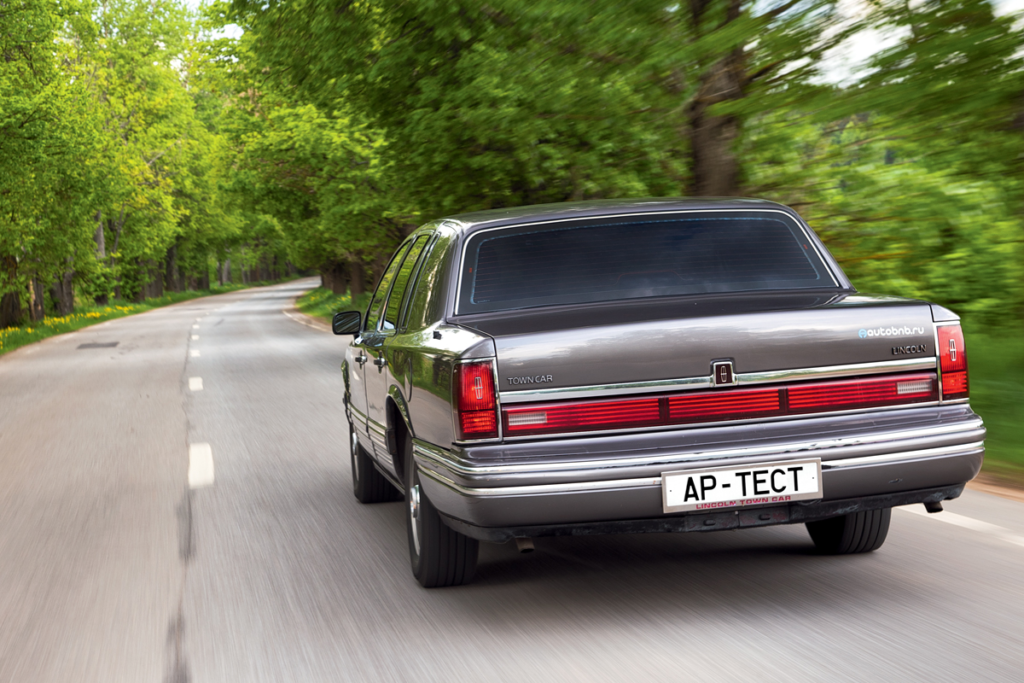
In the base 193-horsepower version of the Town Car 4.6, it had one exhaust pipe, and with the optional split exhaust, the engine developed 213 hp. But the two pipes were installed on this Lincoln already after the sale. But under the hood, there’s already a modernized “modular” overhead engine, which began to be installed on the Town Car in November 1990.
However, that’s precisely what it excels at. Both the Town Car and Fleetwood live with their owners as vehicles of nostalgia, serving as “Titanic joyrides” on the autobnb.ru platform, which functions as the automotive counterpart to popular housing rental aggregators.
While sports and performance cars may dominate the rental market, I believe that beginning with Cadillac and Lincoln offers a unique opportunity to delve into automotive history and trace the trajectory of automotive progress over the past five decades.
Dimensions, weight* and weight distribution along axes
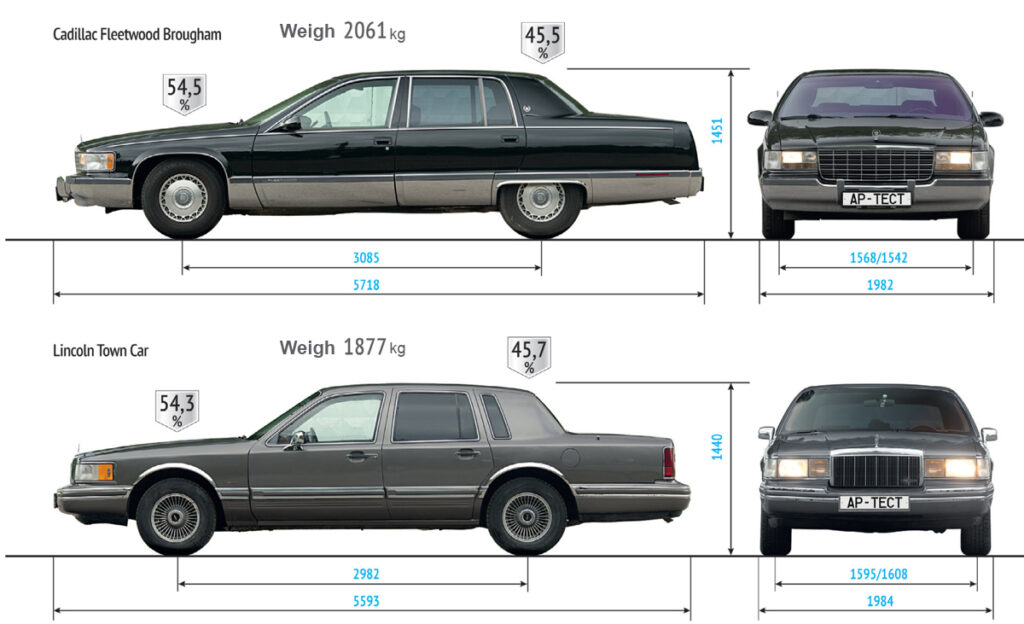
Manufacturers’ data are highlighted in blue/Autoreview measurements are highlighted in black. Dimensions are in millimeters.
*Actual vehicle weight without driver, with full fuel tank and full process fluids
**For right rear seat
**Interior width at shoulder level in the first/second row of seats.
| Parameter | Cadillac Fleetwood Brougham | Lincoln Town Car |
|---|---|---|
| Maximum Speed (km/h) | 209.5 | 168 |
| Acceleration Time (s) 0-50 km/h 0-100 km/h 400 m Path 60-100 km/h (D) 80-120 km/h (D) | 4.5 10.9 17.9 5.6 7 | 4.5 11.3 18.2 6 7.9 |
Some measurement results Autoreview
| Parameter | Cadillac Fleetwood Brougham | Lincoln Town Car |
|---|---|---|
| Seating Capacity | 6 | 6 |
| Trunk Volume (liters) | 588 | 631 |
| Curb Weight (kg) | 2034 | 1827 |
| Gross Weight (kg) | 2250 | 2180 |
| Engine | Gasoline, with central injection | Gasoline, with distributed injection |
| Number and Arrangement of Cylinders | 8, V-shaped | 8, V-shaped |
| Displacement, cc | 5733 | 4601 |
| Cylinder Diameter / Piston Stroke, mm | 101.6/88.4 | 90.2/90.0 |
| Compression Ratio | 10.0:1 | 9.0:1 |
| Number of Valves | 16 | 16 |
| Max. Power, hp/kW/rpm | 264/194/5000 | 193/142/4200 |
| Max. Torque, Nm/rpm | 447/3200 | 353/3200 |
| Drive | Rear | Rear |
| Transmission | Automatic, four-speed | Automatic, four-speed |
| Front Suspension | Independent, spring, on double wishbones | Independent, spring, on double wishbones |
| Rear Suspension | Dependent, spring, four-link | Dependent, pneumatic, four-link |
| Steering Mechanism | Rack and pinion | Rack and pinion |
| Turning Diameter, m | 13.6 | 12.4 |
| Front Brakes | Disc | Disc |
| Rear Brakes | Drum | Disc |
| Base Tire Size | 235/70 R15 | 215/70 R15 |
| Maximum Speed (km/h) | 173 | n/d* |
| Acceleration 0-100 km/h (s) | 9 | n/d |
| Average Fuel Consumption, l/100 km | 13.1 | 13.1 |
| Fuel Tank Capacity, l | 87 | 76 |
| Fuel | Gasoline AI-92 | Gasoline AI-92 |
n/d* – no data
Lord and Panther
This historical context would have been most eloquently narrated by Andrey Vasilyevich Khrisanfov, but sadly, he passed away just a few days before the test. Nevertheless, he had already meticulously penned this background, akin to an entire encyclopedia. Through his extensive narratives on the history of American manufacturers, we learn, for instance, that the Town Car isn’t simply a “city car” but rather a type of horse-drawn carriage where the coachman sits under the open sky while passengers occupy a separate enclosed cabin.
Andrey Vasilyevich also delved into the origin of the term “Brougham,” which stems from the surname of the English lord Henry Brougham. In the late 1830s, Brougham conceptualized a new carriage body—a two-seater carriage featuring windows in the doors but solid panels on the sides of the sofa. This design aimed to shield passengers from prying eyes. Essentially, it resembled a town car but lacked windows on the sides. By the early 20th century, General Motors adopted this term to denote a luxurious trim level for cars with conventional closed bodies. Subsequently, “broughams” emerged from other manufacturers as well.

In the mid-1992, the appearance of the Fleetwood was no longer a secret: Andrey Vasilyevich Khrisanfov explained who was who among the passenger cars on the US market. The purest “American” car at that time was the predecessor of the Fleetwood — the Cadillac Brougham (pictured above). Its share of local components was 99.7%.
Similarly, the name “Fleetwood” has direct ties to horses, as it belonged to the company founded by Henry Fleetwood in Pennsylvania. In the 19th century, Fleetwood primarily produced carriages and carts. By the 1920s, it had become an exclusive “coachbuilder” for Cadillac before being absorbed by the GM corporation.
The designations “Fleetwood” and “Brougham” first surfaced in 1977 on a large rear-wheel-drive sedan, which remained in production until 1986. It was later succeeded by the Cadillac Brougham (with the Fleetwood name designated to a front-wheel-drive sedan), and finally, in 1993, our protagonist emerged—the last rear-wheel-drive Fleetwood Brougham, touted as the largest passenger car in the USA at the time.
Its exterior drew inspiration from concept cars like the Voyage and Solitaire, through which Cadillac sought a refreshed modern image in the late 1980s. However, in 1992, they also introduced the Seville STS sedan, based on the same concept cars, which utilized a more progressive front-wheel-drive platform and carried a similar price tag of around 37-39 thousand dollars.


The Voyage concept cars (1988) and the Solitaire coupe (1989) promised Cadillac a renaissance of “heavy classics” with a modern face. The streamlined body had a coefficient of drag of 0.28 — for this, the front wheels were covered with active shields that extended outward in turns. The front suspension used McPherson struts, while the rear had a transverse spring. The layout was traditional, but the sedan had a V8 4.5 engine (275 hp) and an all-wheel-drive transmission, while the rear-wheel-drive coupe had a V12 6.6 engine (430 hp) developed in collaboration with Lotus. The estimated top speed was up to 320 km/h. This engine did not go into production, but GM’s collaboration with the British brought the LT5 “eight” for the Corvette.
The Seville was the model Cadillac marketers envisioned as a competitor to flagship sedans from Europe and Japan. It was equipped with all the latest technologies, including the quad-valve 32-valve Northstar 4.6 engine (223-305 hp) and adaptive suspension.
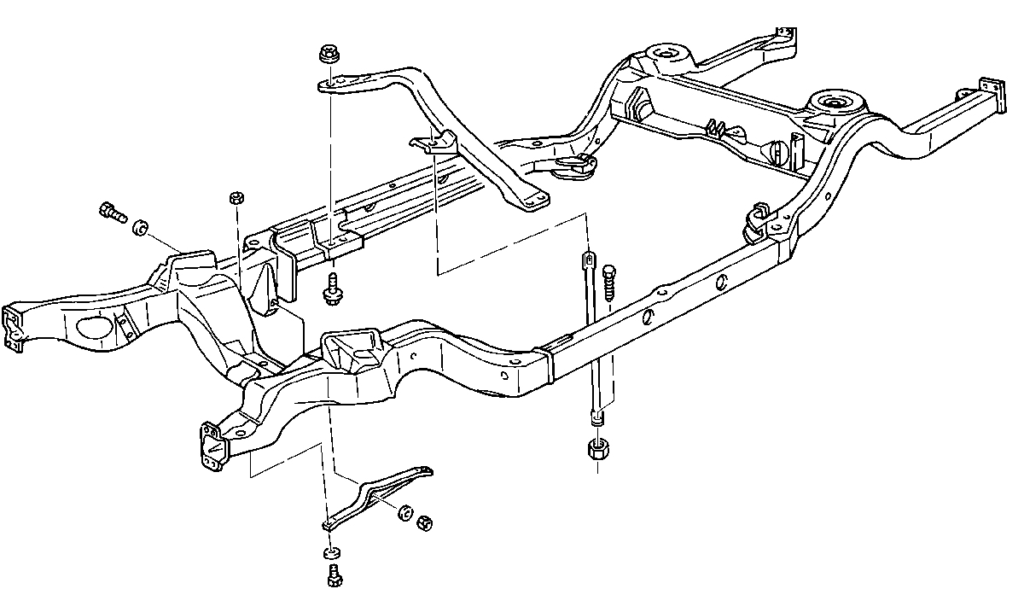
In the 1990s, the frame on sedans was already a relic of the past, but it still retained its practical value: before the crossover boom, large sedans often served as tow vehicles for trailers. For example, the Fleetwood with the optional main pair of 3.42 instead of 2.56 could tow more than three tons. And the frame also facilitated the production of commercial versions, on the basis of which limousines and hearses were built.
Furthermore, in 1994, Cadillac introduced the front-wheel-drive DeVille, precisely targeting enthusiasts of the American full-size sedan. Despite bearing a striking resemblance to the Fleetwood, the DeVille boasted separate climate control, steering wheel-mounted buttons, adaptive shocks, and an equally spacious cabin. These Cadillacs sold at a rate of 100-120 thousand units per year, whereas the total production of the Fleetwood barely surpassed 90 thousand cars in less than four years.
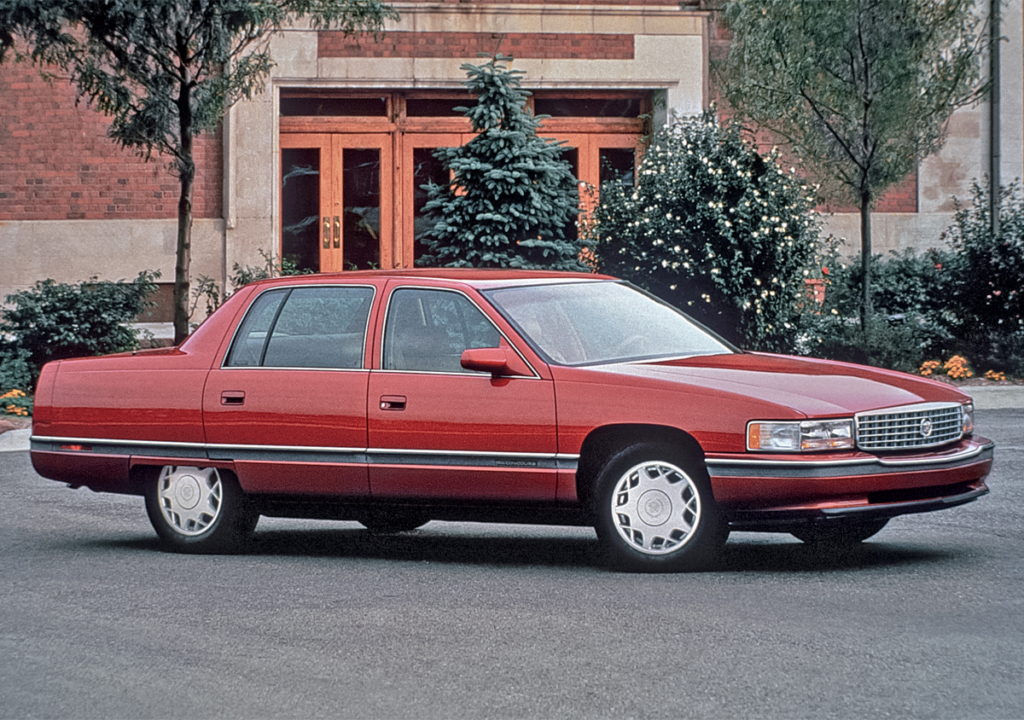
The Cadillac DeVille also evolved from the Voyage concept, but did not receive a V12 or all-wheel drive, instead getting a front-wheel-drive K-body platform that GM had been using since the early 1980s.

The LT1 5.7 engine featured a “reverse” cooling system (head first, then block) and an “optical” OptiSpark ignition distributor, which was regularly flooded with coolant from the cooling system pump.
Even more surprising was the enduring popularity of the more conservative and older Town Car during the same period. Throughout the 1990s, it consistently achieved sales volumes of around 100 thousand cars per year. Remarkably, Ford cut costs on the development of the new Lincoln by utilizing the old Panther platform from the 1980 model. Despite this, the Town Car thrived. Rough engineering from the British company IAD (later absorbed by Daewoo) and body panel production by the Japanese company Ogihara Iron Works were integrated into its design.

The Lincoln’s rear suspension has two pneumatic balloons powered by an electronically controlled compressor. The rear axle attachment to the body is through two longitudinal and two diagonal arms. The Cadillac’s spring suspension is similarly arranged, where the pneumatic balloons serve only to maintain clearance.
Nevertheless, Ford’s astute designers—Jack Telnack (known for the Taurus sedan) and Gale Heldermand (creator of the original Mustang)—combined with strategic marketing decisions proved successful. The Town Car boasted a slightly lower price point, disc brakes on all wheels, cruise control, adaptive suspension, and the largest trunk among all passenger cars in the American market.
GM’s decision to discontinue production of the Fleetwood alongside its platform-sharing sedans, the Buick Roadmaster and Chevrolet Caprice Classic, further cemented the Town Car’s dominance. With the departure of these models, the Town Car reclaimed its status as the largest car in the USA and experienced a resurgence in sales.
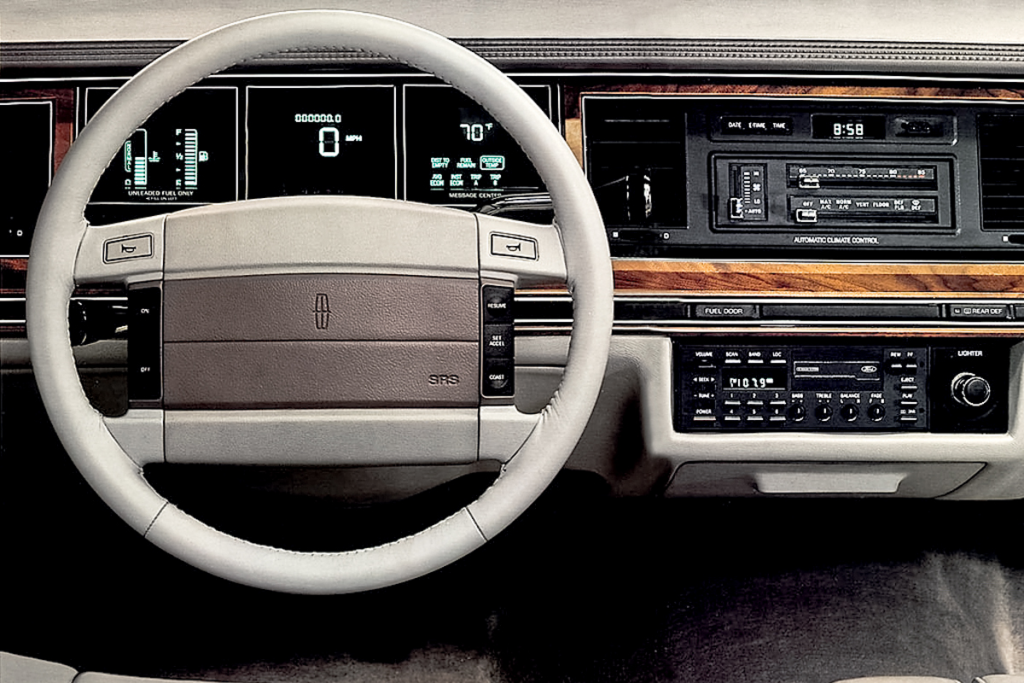
This is how the interior of the 1990 model looked, with an electronic instrument panel and a JBL stereo system.

Only in 1994 did the Town Car receive a cabin that matched the spirit of the times — with smooth contours of the front panel and a two-spoke steering wheel.
In late 1994, Lincoln underwent a facelift, which included updates to the headlights and interior. By the end of 1997, the next generation, featuring a more rounded design and sans opera windows but equipped with a Watts mechanism in the rear suspension, appeared on the same platform. In 2003, the Panther platform received rack-and-pinion steering. Subsequently, by the end of 2007, Ford closed the Wixom plant in Michigan and relocated Lincoln production to Canada, alongside the Ford Crown Victoria and Mercury Grand Marquis models. It was there that the last Town Car was assembled in 2011.
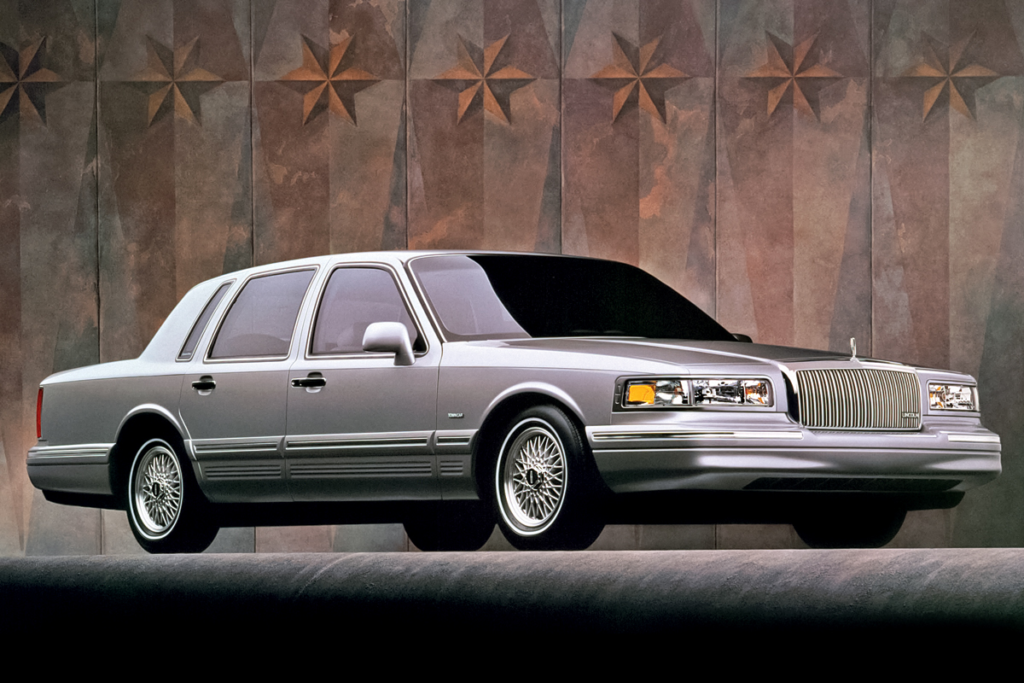
The result of the 1994 facelift was the Town Car with narrow headlights, forward-shifted mirrors, and a new “automatic.” But a plastic intake manifold was installed on the engine, which brought many problems to the owners of elderly Lincolns.
Remarkably, demand for this sedan did not dip below 50 thousand units per year until the mid-2000s. By comparison, in 2021, Lincoln managed to sell a maximum of only 87 thousand cars in the USA.
But is it worth purchasing such cars today? The rarer Cadillac Fleetwood is more intriguing as an investment piece in genuine American youngtimer culture. In the US, these sedans with mileage up to 100 thousand kilometers typically cost around ten thousand dollars, while those with mileage up to 150 thousand kilometers can be found for five to seven thousand. There are cheaper offers, but restoring such a car and battling corrosion in our conditions can prove to be an arduous mission, as many parts are no longer in production.

The armored vehicle based on the Fleetwood carried Bill Clinton from 1993 to 2001 (his predecessor George Bush preferred the Lincoln Town Car), and in the 21st century, presidential Cadillacs were transferred to a special chassis from pickups and trucks.
Regarding the early 90s Lincoln Town Car, it is considerably less expensive—priced at up to 3000 dollars in the US. However, while the engine may be the most problematic component for the Cadillac, the Lincoln necessitates attention to the cooling system, pneumatic suspension, electrical wiring, and numerous body elements prone to corrosion.
Photo: Dmitry Pitersky | Ford Company | GM company
Expert group: Andrey Mokhov | Yaroslav Tsyplenkov
This is a translation. You can read the original article here: Городские Титаники: ретротест рамных седанов Cadillac Fleetwood Brougham и Lincoln Town Car

Published March 21, 2024 • 46m to read

